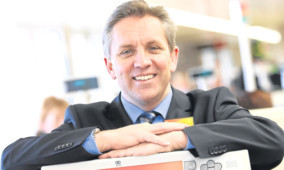Outgoing Sainsbury’s boss Justin King warned of tough times ahead yesterday despite capping his decade in charge of the retailer by delivering a profits boost.
Underlying pre-tax profits rose by 5.3% to £798 million in the year to March 15 a ninth successive year of growth despite like-for-like (LFL) sales for the period edging up just 0.2%.
Mr King, who will be replaced by commercial director Mike Coupe in July, said a focus on quality, affordable own-brand products had helped Sainsbury’s succeed in a tough retail environment.
However, the firm said profits were likely to decline in the current financial year as LFL sales were likely to remain flat.
Retail analysts are forecasting a fall in underlying profits to £762m for the current year.
Evidence of a slowdown came in the company’s latest quarterly trading figures in which it reported a LFL sales fall for the first time in more than nine years.
“While the general economic outlook is showing some signs of improvement, conditions in the food retail sector are likely to remain challenging for the foreseeable future as customers continue to spend cautiously,” Mr King said.
Despite the sales slowdown, the annual results showed the firm’s market share remained at 16.8%.
The figure is the highest achieved by the retailer in a decade.
Capital expenditure at Sainsbury’s came in at £888m for the year, well below market expectations as the group spent less on logistics, IT and land for future development.
But the group said it was pushing ahead on developing new revenue streams beyond its core business with in-store pharmacies, mobile phones, ebooks and household energy all forming part of its long-term strategy.
Announcing a 3.6% increase in the full-year dividend to 17.3p, chairman David Tyler hailed a performance which had seen improving profits achieved against a challenging economic backdrop.
He also paid tribute to Mr King’s stewardship over the past 10 years.
“His ‘Making Sainsbury’s Great Again’ plan transformed our business and has seen Sainsbury’s consistently outperform the growth of the market.
“Under his leadership, customer transactions have increased by 10m a week to around 24m, annual sales have grown by £10.3bn to £26.4bn and underlying profit before tax has trebled to £798m.
“He has been a truly exceptional leader.”
A central tenet of the rejuvenation plan has been a switch of focus from major supermarket developments to convenience stores.
The company revealed it had taken a £92m hit in 2013 after scrapping planned supermarket developments, though it still opened 13 but said it had opened 91 convenience outlets in the same period, with sales reaching £1.8bn.
Shares closed the day 9.5p lower at 323.9p.
